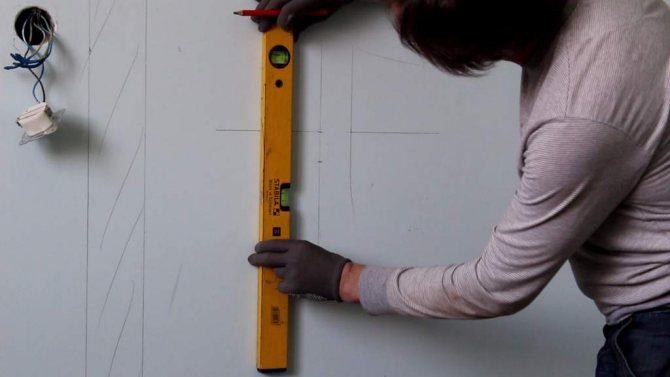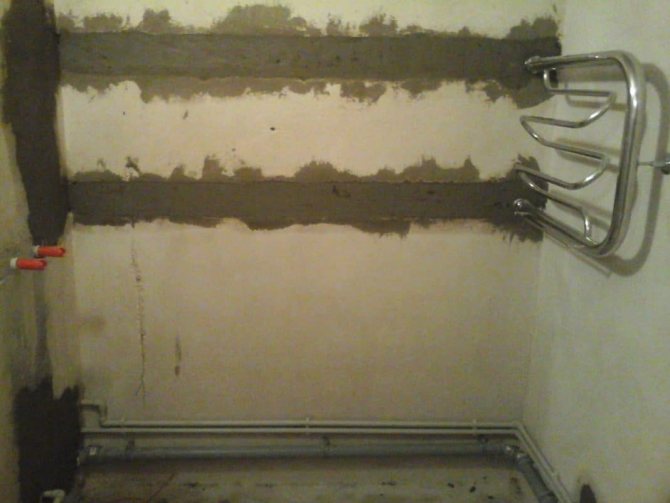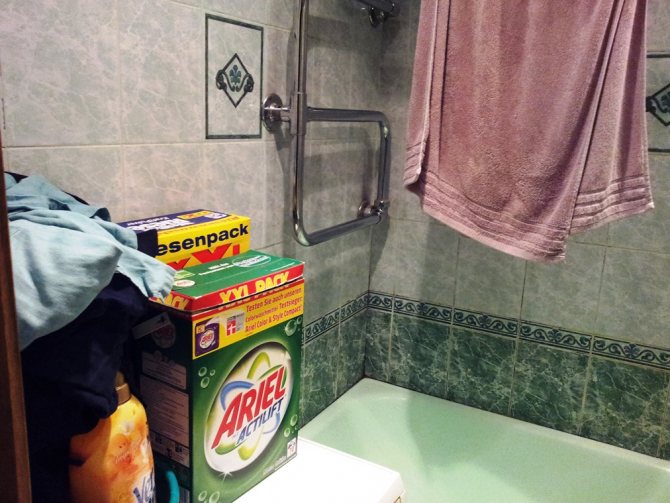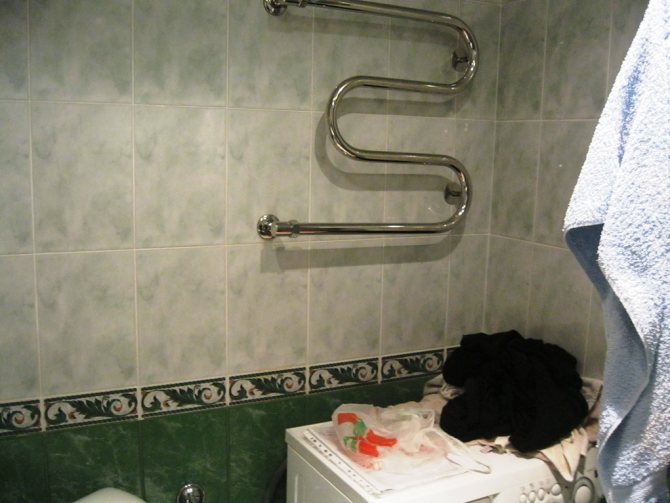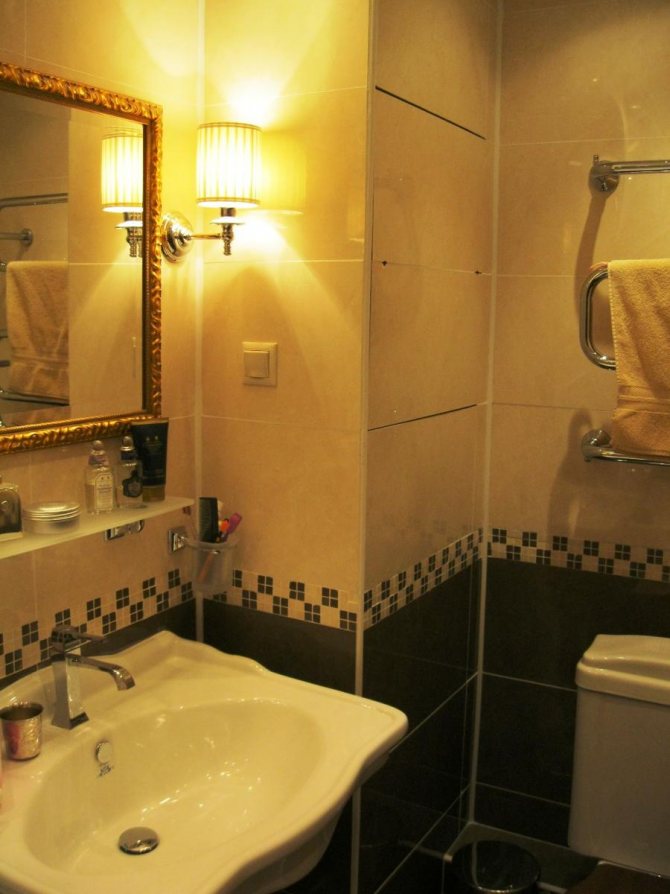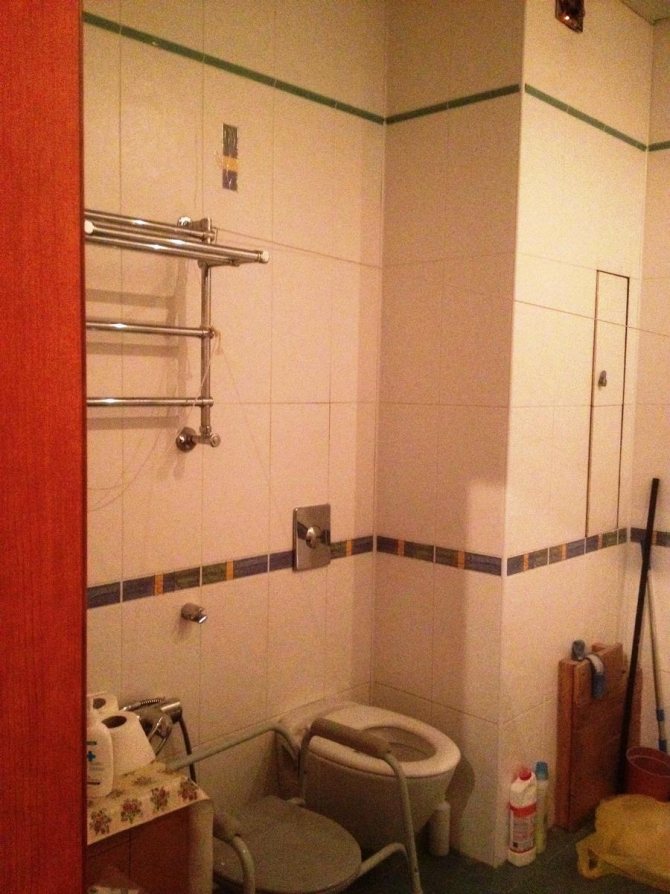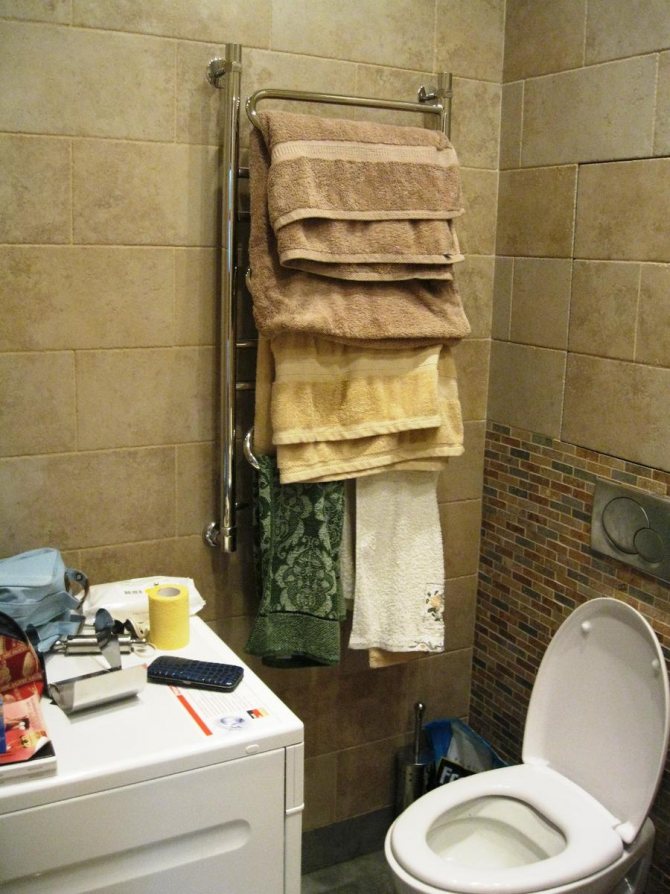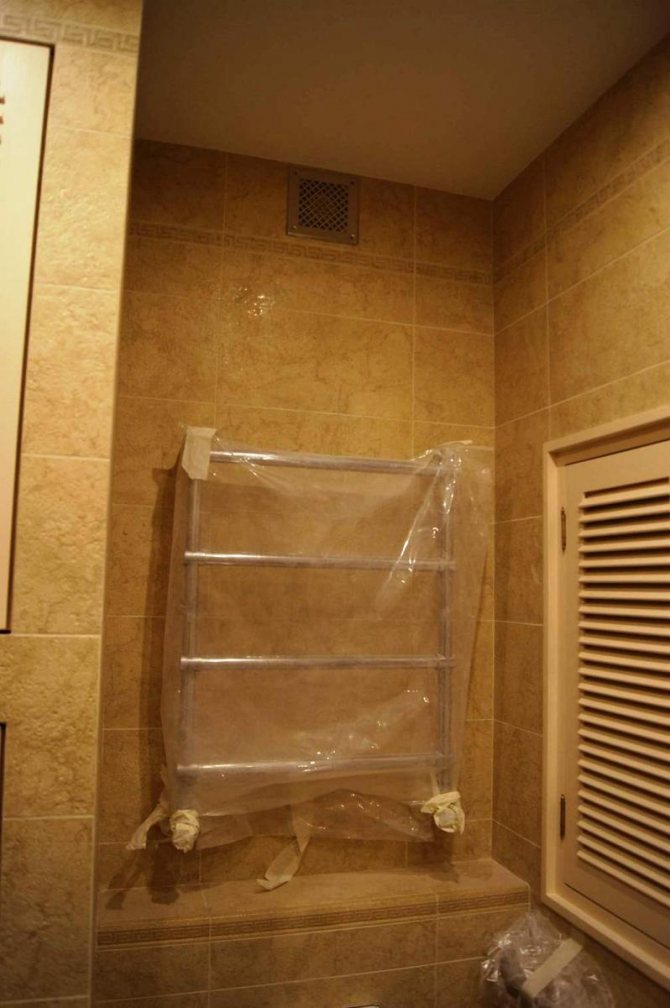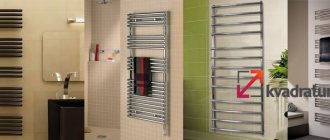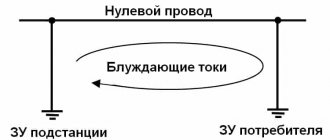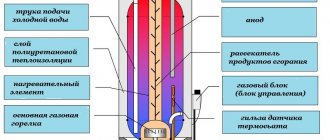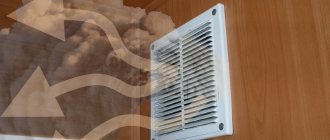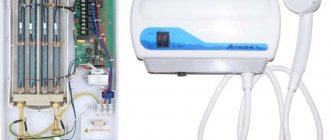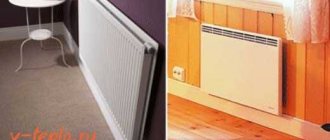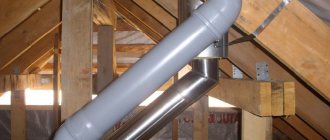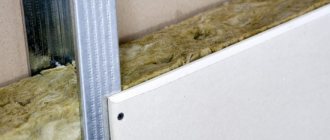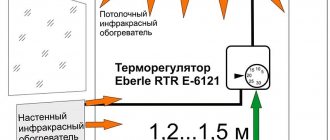Repair in the bathroom always affects the electrics, as well as plumbing communications.
Most often, a heated towel rail is located on one side of the bath. This is ideal if you plan to leave the bathtub in place. But what if you decide to install a shower stall? The heated towel rail is not always located well: there are times when it interferes, or reduces the useful space of the bath and does not allow it to be used fully.
In order to correctly determine the place for the heated towel rail, you need to study the technical documentation attached to your home. The transfer is carried out only by documentary confirmation and agreement with the ZhEK.
Types of heated towel rails and their advantages
Heated towel rail
Let's clarify that there are several types of heated towel rails, each of them has advantages, they are not without some disadvantages.
Typically used devices:
- Standard water ones - work when connected to the hot water supply of a house or its heating system. The problem with such a device is associated with the possibility of operation only during the heating season or in the presence of hot water. Otherwise, the device will be useless. The second point is the difficulties with the connection - its illiterate implementation can have a negative impact on the operation of the water supply or heating system of the whole house.
- Electric heated towel rails - metal tubular structures with an electric heater inside. The big advantage of such a device will be the ability to work independently.
- Universal heated towel rail - Probably the most convenient and unpretentious option. It runs on both hot water and electricity. The only drawback will be the price for such devices - almost 2 times higher than for standard models.
There are also very convenient portable electric models, they are installed on the floor, they do not require any installation, they can be used not only in the bathroom, but in the kitchen or in the room, as a heating device.
Water type model
The mechanism of transferring a water heated towel rail is more complicated. However, it is possible to do the job yourself.
Design features of the water model
A dryer of this type consists of the following elements:
- there is a Mayevsky valve on top of the device. Its purpose is air release;
- there is a plug - a special plug;
- water is supplied through the supply system;
- the water is shut off by valves specially mounted in the device. If there are none, you need to install them yourself;
- fasteners - brackets.
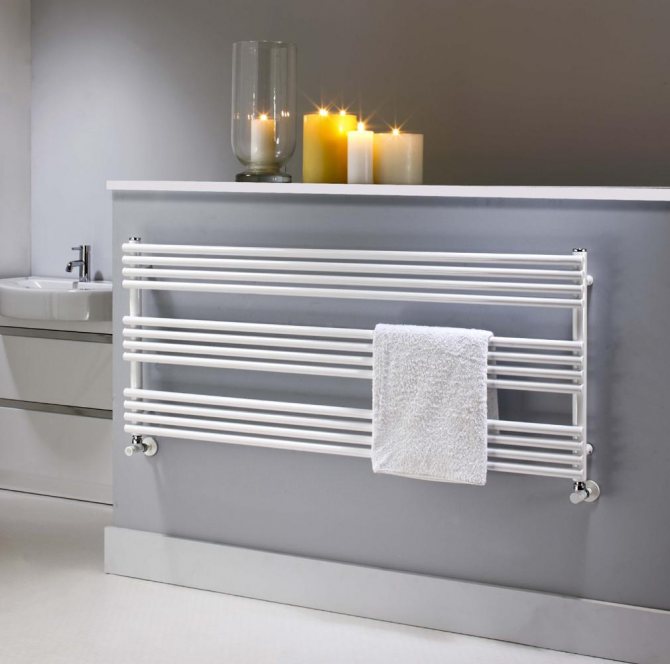
The dryer works in some cases from the heating system, in another version from hot water supply. The second option is more preferable:
- The heating season is short. Heating works for a maximum of 6 months.
- When a breakdown or leakage of the dryer is detected, you must immediately shut off the water supply to the coil. With a plumbing, it is quite possible to do this quickly. It will be difficult to do this with a heating system.
- There are fewer impurities in the water of the plumbing system than in the liquid of the heating system. In addition, water stagnates in the heating system and becomes even more clogged.
Before moving your heated towel rail to another wall, apply for a permit from your local authority. It is impossible to start work without approval. Before starting work, a specialist from the housing department is called in to cut off the water supply to the entire riser.After all, the liquid must be drained completely.
Requirements for choosing a new model
The new model of the heated towel rail must meet the requirements:
- The new model is selected according to the pressure level in the water supply system of the apartment.
- The size of the model changes in direct proportion to the size of the room. A large bathroom has a large heated towel rail.
- A model is selected taking into account the diameter of the outlet pipe. The indicator should correspond to the diameter of the inlet of the riser pipes.
- It is recommended to opt for a seamless pattern.
How to choose a heated towel rail
When choosing an installation, you should pay attention to imported devices.
Models made in Germany and the Czech Republic are in demand in the market, they are of better quality than from a domestic manufacturer.
When choosing, special attention should be paid to seamless patterns.
When choosing, we take into account that the best option is a stainless steel product or a more expensive brass product.
But if you live in a country house or a cottage, entrusting heating and drying towels should be models made of ferrous metal or brass. With good quality, such a device will last more than twenty years.
Let's watch a video on how to choose the best model:
Towel dryer transfer rates
The transfer of the device to another wall as a violation by the housing inspectorate will not be assessed, since the structure is not indicated in the plans of the BTI and a change in its position will not affect the configuration of the layout of the room.
Heated towel rail connection diagram
Often there are other problems with the transfer, because the device belongs to the common property of the house, and will require the collection of signatures for permission to transfer, from all residents of the house.
But in the plans of the BTI, the device is not included, and it works for each apartment separately.
At the same time, a water heated towel rail is supplied to the heating or hot water supply system of the house and, if connected incorrectly, can affect its operation. All three points will need to be taken into account when carrying out repair work.
To correctly carry out the transfer of the device, you will need to comply with some technical conditions.
| for water device | the wall on which the device is planned to be placed should not be adjacent to the bedroom or living room the pipes used for connecting must be either heating or heat-resistant, capable of withstanding high temperature and pressure the device must be seamless and have protection against water shock loads it is advisable to carry out the transfer at a minimum distance from the previous location |
| for electric | it is recommended to calculate in advance whether the permissible load on the electrical wiring of the apartment will not be exceeded take care of the availability of a convenient outlet for connecting the device |
Do not forget the standards specified in SNiP:
- A ladder-type heated towel rail is attached in such a way that an adult can reach the upper bar;
- U-shaped is mounted not lower than 110 cm from the floor.
- M-shaped is placed at a height of at least 90 centimeters;
- The average value of the attachment height is from 90 to 170 centimeters, for convenient human use.
Stages of work ↑
You should start transferring a heated towel rail connected to a heating or hot water supply system by turning off the water supply. This procedure should be performed by a locksmith from the home service organization. Amateur activities can be very expensive. It is best to warn the neighbors in advance and inform them not only about the shutdown, but also about the planned timing of the work. Subsequent work is carried out in this order:
- Dismantling of old equipment. With the help of the "grinder" old communications are neatly cut out.In this case, it is necessary to ensure that the remaining segments are of sufficient length to tie the new pipeline.
- Installation of a bypass with shut-off valves and subsequent pressure testing of the system.
- Laying the pipeline from the new installation site of the heated towel rail to the riser. If the new equipment will be significantly removed, it is best to perform hydraulic engineering calculations that will allow the pipeline to be correctly positioned. Otherwise, the device will not be able to warm up to the desired temperature. The pipeline can be laid along the wall or hidden inside it under a decorative coating. The second method is more aesthetic, but also more time consuming.
- Marking the wall and fixing a heated towel rail on it. Connection of equipment to the supplied pipeline.
- System health check.
- Carrying out the necessary finishing work.
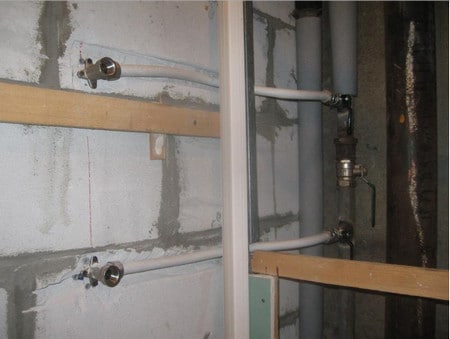
Dismantling of old equipment should be carried out so that a new pipeline can be tied to the system.
The apparent simplicity of the process of transferring a heated towel rail should not be misleading. The particular complexity of such work is associated with the fact that the equipment has to work under high pressure conditions. The slightest inaccuracy in installation or design can lead to disastrous consequences. Therefore, it is best to entrust responsible work to competent specialists. They will quickly and efficiently transfer the heated towel rail to any place convenient for the customer.
Transferring a heated towel rail to another wall - is it necessary to agree
There are 2 ways to agree on the transfer of a heated towel rail:
- If the house is undergoing repairs and redevelopment, then it is worth noting the transfer in the project documentation, which will need to be submitted for approval to the housing inspectorate, which will subsequently allow or prohibit the transfer;
- If you just want to start repairing and redeveloping the house, then it would be better to carry out the transfer of the device with the help of the employees of the management company, who will enter the new location of the installation.
It is always worth discussing the transfer with the relevant authorities. If there is a breakdown in the water supply of the whole house, only you will be to blame, since you did not agree on the transfer with the housing inspectorate.
Before installing a new heated towel rail, you need to calculate whether it will give an additional load on the heating system of the house. The device must be completely original and free from defects.
The nuances of transferring equipment ↑
There are a number of rules that must be taken into account during the work on the transfer of the device:
- The design and shape of the device must correspond to the side of the location of the supply communications and the amount of free space intended for installation.
- The heated towel rail must be equipped with a so-called bypass - a pipe bridge of the device circuit with a tap. It is necessary to maintain the health of the heating system in the event of a sudden emergency.
- In the bypass area, shut-off valves are mounted on both sides. Their use makes it possible to carry out the necessary repair and maintenance of the device.
- New communications should have a minimum length and cross-section equal to the originally established pipe diameter.
- The installation of the equipment should be carried out without significant level differences that can lead to the formation of a hydrodynamic air lock. Therefore, it is recommended to lay the pipeline horizontally with a slight slope in the area of fixing the device.
- The pipes used during the transfer must be classified as "heating", that is, they must withstand strong heating at high pressure.
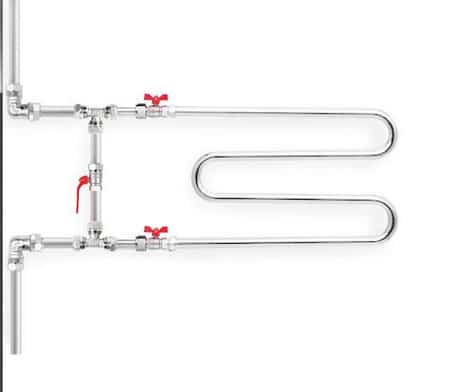

Bypass is a necessary element when installing a heated towel rail
Transferring the structure as a design solution
The world is gradually leaning more towards minimalism, and therefore small and neat models are gaining more and more popularity.
Such a device has many advantages:
- Great view;
- Takes up little space in the bathroom;
- It is cheaper;
- Due to its small size, with a poor pressure of hot water, it will be just as hot
Of the minuses, it is worth noting that such a device is not suitable for all baths. For large baths, such a unit will be disproportionately small.
Heated towel rail as a decor item
There are companies that produce custom-made heated towel rails. You can order a design service and make a device according to your sketch, the required dimensions and colors. It will fit neatly into the bathroom interior. Colored models look good in a bathroom, the interior of which has a bright color scheme.
For standard bathrooms, a stainless steel model is better suited.
The best place to install is above the washing machine. According to the rules of SNiP, the distance from the household appliance to the plumbing equipment should not be less than 60 centimeters.
How to prepare for the job of replacing or moving a heated towel rail in a bathroom to another wall
To begin with, it is worth preparing the tools:
- perforator
- drills for working on concrete
- electrical tester
It is advisable to prepare screwdrivers, tape measure, marker, mounting brackets.
Convenient place to install a heated towel rail
It is worth choosing the right place for installation, as mentioned earlier, it is best to install a heated towel rail above the washing machine, about one hundred and twenty centimeters, and a sufficient distance from the pipeline.
After determining the installation location, it is worth marking it with a marker. It is desirable that there is a power source (socket) near the installation site. But if there is none, then you will have to lay a separate wire for our device.
There are 2 ways to lay a new socket:
- With a complete bathroom renovation, laying a wire under the cladding is a reliable option.
- It is also possible to run the wire directly over the cladding, but this will not be as safe. The first option, although more complicated and more time consuming, will be much more reliable than the second.
Then you need to dismantle the device from the place of its initial installation.
We make new holes in the marked place for the fastening system of the device. All that remains to be done is to install the mounting system and put the device itself on it. After finishing the finishing work.
We offer you to watch an interesting video about installing a new heated towel rail:
Transferring a water heated towel rail, what difficulties arise
Firstly, there may be legal problems with the permission to transfer, and secondly, when moving the water apparatus, there may be problems with the load of the new structure on the water supply system of the house.
All other difficulties are not serious compared to the first two.
Before starting the transfer, it is imperative to turn off the supply riser. It is not recommended to do this on your own; it is better to entrust this to a professional plumber.
Usually, water devices do not have a heat regulation system, but a ball valve can be installed on it, which will allow regulating the heating of the installation.
First of all, it is always worth finding out if the transfer of the structure in the house is allowed. If not, then it is imperative to coordinate this with the relevant authorities.
If you carried out the transfer of the installation and did not agree with the housing inspectorate, then you will be brought to administrative responsibility. The case can go to court, and you will have to be punished or get off with a tidy fine.
Watch the video, an interesting and safe option for connecting a heated towel rail:
Putting the heated towel rail into operation
After the end of the work, water is connected, and then air is removed from the circuit. The system is checked for leaks.If defects are found, the riser is closed again and the problem area is repaired.
If the supply pipeline is hidden in the wall, it should be checked beforehand by creating double pressure in the branch of the heated towel rail.
At first glance, the process of moving the instrument seems simple. However, the equipment operates under high pressure and temperature conditions. Errors or inaccuracies in installation can lead to accidents. It is especially important to make high-quality welding and sealing of threaded connections. In the absence of certain skills, the work should be entrusted to specialists. Watching the installation video will be useful, but not enough to gain the necessary experience and knowledge. The price for transferring a heated towel rail can be lower if you independently prepare and decorate the room.
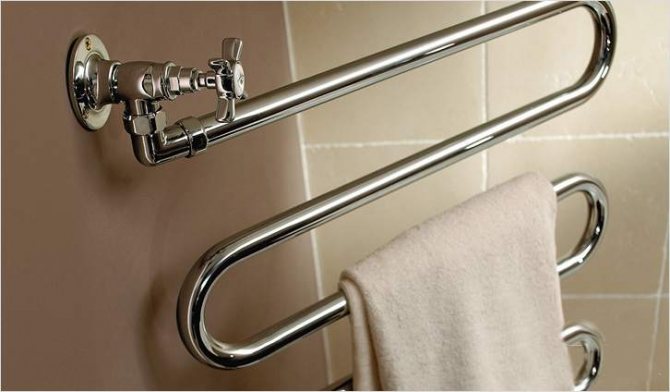

Note: the price of transferring a water heated towel rail to another wall in Moscow starts from 3,000 rubles, in St. Petersburg - from 2,500 rubles. This cost does not include welding, pipe installation, wall chasing, threading. The total cost of moving the instrument will depend on the length, diameter and material of the pipes.
Features of installing an electric heated towel rail
Electric heated towel rail
It will be much easier for residents of private houses to choose a place to install the unit. Residents of apartment buildings have a limited number of options for choosing a location.
The electrical design won't give you much of the hassle of transferring to another wall. It is not necessary to coordinate the transfer of such a device with the housing inspectorate.
There are two nuances that exist when transferring an electric heated towel rail:
- The distance from the water source must be at least 60 centimeters;
- Correct power supply connections.
The electric model has a large number of advantages over its water counterpart, here are a few of them:
- Closed loop allows email. a heated towel rail to be in working order all year round.
- With such a device, you should forget such words as: corrosion, hard water and pressure drops.
- And of course the biggest plus will be the ability to adjust the heating power.
Methods to improve performance and safety:
- It is necessary to carefully hide the wiring that is connected to the heated towel rail;
- It is worthwhile to ground the device due to the fact that it is installed in a room with high humidity;
- It is advisable to install an RCD (residual current device)
Heated towel rail - "G3"
A nice bonus for owners of electric models is the ability to move them from place to place. At the same time, there is no need to coordinate your actions with the management company, since general building communications will not be involved.
Moving an electric heated towel rail is most often attributed to 3 reasons:
- The desire to update the design and layout of the bathroom;
- Disagreement with the original place of installation of the device by the developer;
- The need to use the heater in a more problematic, damp place.

